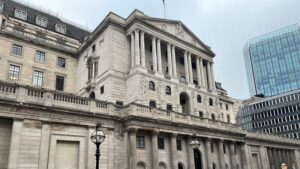The FTSE 100 firm’s reported profit before tax over the first six months of the year was 5% higher at $10.2bn, a marked improvement from its first quarter performance. Excluding currency effects and significant one-off items, profits rose 12% to around $12bn.
HSBC was one of the FTSE 100’s top risers Monday morning, with its shares up 1.7% at 755.5p at the time of writing.
The bank’s announcement of an additional $2bn share buyback programme, to be completed in the second half of 2017, added further cause for celebration.
Further added security for investors came in the form of the bank’s CET1 ratio, which measures its financial strength, up from 13.6% at the end of 2016 to 14.7%, and the $0.9bn in cost savings achieved over the period.
However, like its peers Lloyds and Barclays, HSBC also saw an increase in claim volumes, forcing the bank to siphon off an additional $300m.
Chief executive Stuart Gulliver was quick to distinguish the bank’s “excellent half year performance” from Q1’s mere “good set of results,” arguing the company’s strategic review undertaken in 2015 was starting to bear fruit.
Though the bank has come a long way, Hargreaves Lansdown senior analyst Laith Khalaf was cognisant that much of the bank’s future performance rides on its success in Asia.
“Following a spectacular rise in its share price over the last year, HSBC now accounts for around 6% of the UK stock market, so almost anyone in the country with a pension has an interest in how the bank performs,” Khalaf noted, adding the caveat that despite the bank’s UK listing, “HSBC is far from a UK operation”.
“Three quarters of its profits come from Asia, which shows which side of the world HSBC’s bread is buttered on.
“This means the key driver of the bank’s performance will be the east, not the west, positioning the bank well to capitalise on the growth of developing Asian economies, though that of course comes with a risk warning attached.”
To that extent, the British bank delivered, taking in £7.6bn in profit from its Asian businesses and attracting new business to its Asian insurance and asset management units, which saw 14% higher annualised new business premiums and 17% growth in AUM, respectively.
The bank won new mandates, including several connected with Xi Jingping’s Eurasian infrastructure project, the Belt and Road Initiative.
On the bank’s share buyback scheme, Khalaf agreed that “in theory” it was a good way to sweeten the deal for shareholders but cautioned that “markets can still get addicted to these schemes, with the associated withdrawal symptoms if they are taken away”.
The Share Centre investment research analyst Graham Spooner was generally positive on the group’s prospects but issued a cautionary note of his own.
“We continue to recommend HSBC as a ‘buy’ for medium risk investors seeking income,” he said.
“We would however, suggest building a holding over time as the company continues to face potential challenges which include political, regulatory and slower global growth.”







